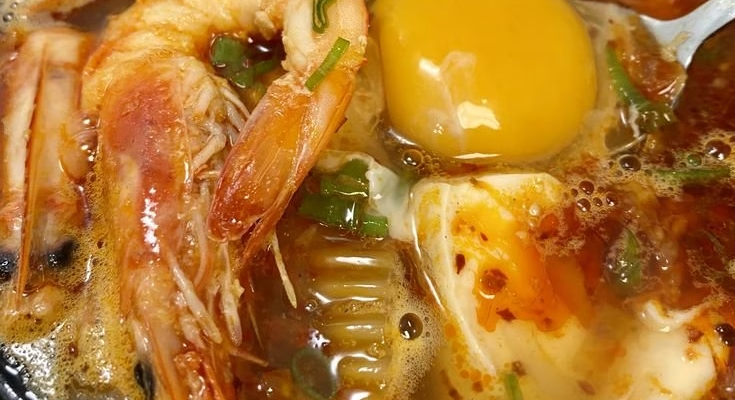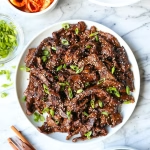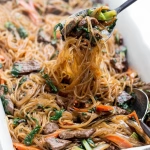
Haemul Sundubu (Seafood Tofu Stew) is a warm, comforting dish that bursts with flavors of the sea and vibrant spices, making it a cherished staple in Korean cuisine. Originating from the coastal regions of Korea, this stew offers a delightful combination of soft tofu and an array of fresh seafood, simmered in a rich, spicy broth. Traditionally enjoyed during cold weather, it warms your soul and brings loved ones together around the table.
In this article, we’ll explore how to create an authentic Haemul Sundubu (Seafood Tofu Stew) at home. You’ll learn about its key ingredients, step-by-step cooking instructions, and some handy tips to make your stew sing with flavors. Whether you’re a seasoned cook or a curious beginner, you’ll find everything you need to whip up an irresistible pot of Haemul Sundubu (Seafood Tofu Stew) that will impress your family and friends.
Ingredients
| Ingredient | Measurement | Description |
|---|---|---|
| Soft Tofu | 1 block (about 300g) | *Soft tofu is the star of Haemul Sundubu (Seafood Tofu Stew), giving it a silky texture that absorbs the flavorful broth.* |
| Mixed Seafood (shrimp, squid, clams) | 300g | *A mix of fresh seafood adds a briny depth and enhances the umami flavor of the dish.* |
| Vegetable Oil | 2 tablespoons | *Vegetable oil is used for sautéing ingredients, allowing the flavors to meld beautifully in the stew.* |
| Garlic | 4 cloves, minced | *Fresh garlic enhances the aroma and depth of flavor in Haemul Sundubu (Seafood Tofu Stew), giving it a robust kick.* |
| Onion | 1 medium, diced | *Sweet onions form the base of the stew, providing sweetness and richness when cooked.* |
| Korean Red Pepper Flakes (Gochugaru) | 2 tablespoons | *This spice is crucial for adding heat and that signature reddish color to Haemul Sundubu (Seafood Tofu Stew).* |
| Seafood Soy Sauce | 3 tablespoons | *Seafood soy sauce enhances the umami quality and brings out the fresh seafood flavors.* |
| Green Onions | 2, chopped | *Green onions are a lovely garnish, adding a pop of color and fresh flavor to the finished stew.* |
| Water or Seafood Broth | 4 cups | *Using seafood broth intensifies the flavors, making your Haemul Sundubu (Seafood Tofu Stew) even more delicious.* |
Step-by-Step Instructions
- Step 1: Prepare the Ingredients – Start by gathering all your ingredients for an organized cooking process. Rinse and cut the seafood into bite-sized pieces and mince the garlic. Dicing the onion into small pieces will help it cook evenly and blend into the stew.
- Step 2: Cook the Base – In a large pot, heat the vegetable oil over medium heat. Add the diced onions and sauté until they turn golden brown. This caramelization will lay a sweet foundation in the broth. Once the onions are ready, mix in the minced garlic and Korean red pepper flakes (gochugaru), stirring for about a minute until fragrant.
- Step 3: Add the Liquid – Pour in 4 cups of water or seafood broth gradually, stirring to combine. Bring the mixture to a bubbling simmer. This step is crucial for developing rich flavors in your Haemul Sundubu (Seafood Tofu Stew).
- Step 4: Introduce the Seafood – Carefully add the mixed seafood to the pot. Allow it to simmer for about 5-7 minutes until the seafood is cooked through. You want the shrimp to turn pink and the squid to become tender.
- Step 5: Incorporate the Tofu – Gently add the block of soft tofu into the stew. Avoid breaking it too much! Carefully stir to mix it without crumbling. This part is essential for enjoying those silky tofu bites in every spoonful.
- Step 6: Season and Garnish – Add the seafood soy sauce and taste the broth, adjusting the seasoning to your liking. Finally, sprinkle chopped green onions over the top and let it simmer for a couple more minutes.
Pro Tips
- Tip 1: To enhance the flavors, let your broth simmer longer if you have time. The more it cooks, the richer the flavors become.
- Tip 2: Feel free to customize the seafood! Scallops or fish fillets can add another layer of taste to your Haemul Sundubu (Seafood Tofu Stew).
- Tip 3: For extra heat, add sliced fresh chilies when incorporating the seafood. Adjust according to your spice tolerance!
- Tip 4: Serve Haemul Sundubu (Seafood Tofu Stew) with a side of steamed rice to balance the spice and enhance your meal experience.
- Tip 5: If you enjoy a thicker stew, simmer it uncovered for the last few minutes to let some water evaporate and concentrate the flavors.
Nutritional Information
| Nutrient | Per Serving (1 bowl) |
|---|---|
| Calories | 320 |
| Protein | 25g |
| Carbohydrates | 15g |
| Saturated Fats | 2g |
| Fiber | 3g |
| Cholesterol | 75mg |
| Sugars | 3g |
| Total Fat | 12g |
FAQs
What is the best way to store Haemul Sundubu (Seafood Tofu Stew)?
To store your leftover stew, let it cool to room temperature, then transfer it to an airtight container. It can last in the refrigerator for about 3-4 days. Reheat gently on the stove, adding a splash of water if it thickens too much.
Can Haemul Sundubu (Seafood Tofu Stew) be made vegan or gluten-free?
Absolutely! For a vegan version, substitute seafood with mushrooms or tofu. Use gluten-free soy sauce to ensure the dish remains gluten-free.
What are the best side dishes to serve with Haemul Sundubu (Seafood Tofu Stew)?
Side dishes like steamed rice, pickled vegetables, or a fresh salad beautifully complement the stew. They balance the flavors while providing a refreshing touch.
How long does it take to prepare Haemul Sundubu (Seafood Tofu Stew)?
The total preparation and cooking time is around 30-40 minutes, making it a quick yet satisfying meal option for busy days or cozy dinners.
Can I freeze Haemul Sundubu (Seafood Tofu Stew) for later?
Freezing Haemul Sundubu is generally not recommended as seafood can become rubbery. However, if you must freeze it, store the broth without the tofu and seafood, then add fresh ones when reheating.
Haemul Sundubu (Seafood Tofu Stew) is more than just a meal; it’s an experience filled with steaming flavors and comforting warmth. This delightful dish brings the essence of Korean cuisine to your home, perfect for chilly evenings or whenever you crave something cozy and satisfying. Dive into this recipe, and enjoy the process of cooking while savoring the wonderful aromas that fill your kitchen.
Give this Haemul Sundubu (Seafood Tofu Stew) recipe a try! We’d love to hear about your experience. Did you make any variations or add your special touch? Share your thoughts in the comments below!






